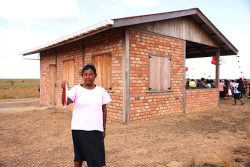SB: After the recent Market Day at Mocha, you advocated that the farmers and agro-processors there be afforded a market as well as processing & packaging facilities. Do you think that the scale of their operations warrant that level of investment?
PF: For the last fifty five years we have been asking people to plant, to produce and to grow local. Farmers have produced and there is no market… with the exception of rice, that is. The farmers in Mocha/Arcadia have the acreage. Perhaps a medium-sized market outlet may be appropriate. Once farmers can see that markets are there, production will increase.
SB: Should this be a government investment or a private enterprise pursuit?
PF: I believe that the government should fund the market in the medium term. In the short term it should be the NDC and the people who are involved presently. Over the next two to three years, the government can establish a market-friendly environment. It does not have to be a fixed structure. Farmers’ markets are usually open places like the Vendors Arcade. They must be attractive and secure. There is no one model.
SB. We have heard of challenges like flooding, land lease issues, wild animals, roads etc. Is the Cooperative disposed to tackling those problems?
PF: There should be inputs from both government and people here. With regard to flooding that can be controlled by continually clearing the kokers, outfalls and drains. The farmers cannot afford to do that but the community as a whole can clean their canals and drains. We also need to look at climate-smart options. We may have flooding, so we have to come up with climate-smart solutions. The farmers will have to use raised beds for perishable vegetables. This is happening elsewhere. There are other solutions like aerial planting, the selection of crops, and a sequence in timing of planting. Aquaponics and hydroponics are ways of raising beds to alleviate flooding. These are all climate-smart solutions. Climate change is an issue that farmers have to take into consideration. It is not just flooding. There are issues with salt water intrusion.
SB: The recent Market Day was pretty impressive. Would you say that Mocha/Arcadia is now an agricultural hub?
PF: Yes but I would like to see it as an agri-penoreal, meaning that it is not just primary production that is going to go on there but also secondary production. There are lots of people in processing. There are linkages being established among various industries. We have to move primary production into other areas. We have the technology available. At the University of Guyana we have done so many things that have been successful. We have not, however, been able to get the farmers to adopt the technology. The people we are training at UG and the Guyana School of Agriculture are not hitting the ground. If one out of every ten or twenty farmers is a UG or GSA graduate can you imagine the kind of development that would go on? At least 50% of the trained people must hit the ground running. The government has to make this it possible. They must not only hit the ground as Advisors. They must hit the ground as producers.
SB: What are the sorts of technology that we need to accelerate the process?
PF: Improved storage production facilities; multi-nutrient blocks for sheep and beef. This system could involve many different tiers of entrepreneurship. The silage production could be a stand -alone process or an integrated one. The silage example could be like the water you purchase. The trucks drive up and deliver bottles of water and you give them the empty bottles, it is a roll-on roll-off system. That is a system I used in Barbados and it is amazing. What I discovered is that almost all the farmers I was working with in Barbados have degrees of some kind… so when I tell them about something it’s very easy for them to adopt. This has not been the case in Guyana. I introduced the technology to compress the storage in a forty five gallon drum. I introduced the automated press in Barbados and in Belize, but not in Guyana.
SB: On the whole, cooperatives across the country appear not to have prospered over the years. Is there, in your opinion, any particular reason for this and can Mocha make a difference?
PF: The answer to that question is that I really do not know why cooperatives in Guyana have survived. This is a question I have been asking myself a long time so I set about looking at cooperatives in other countries… in Mondragon, Spain. I also visited several of them in the United States while I was a student there. I also visited some in Latin America. They were managed by professionals. The cooperatives hired these people to manage their business and all of these people are professionals and they are accountable to the members.
I visited the Cristiano Potato Growers Association in Jamaica. All of the successful cooperatives that I visited were managed by professionals. If there is a disease outbreak they know how to fix it. The membership can now concentrate on whatever they do best.
I visited one in Latin America. They had small acreages and they all market their produce through the co-operative managed by an agronomist and other professionals. I asked the farmers if they are satisfied, they said “Yes, because we are making money and if they do not do what is good for the cooperative we fire them.”
Here in Guyana, when we put people in the seat of management in the co-op we have to choose them carefully, based on competence in specific areas. For example if it is a food cooperative, we will have to get someone who knows about food manufacturing. If we cannot find that person and if there is someone within the group who has the competence then we will have to pay [him or her]. Every place that I visited had that system and it worked well. Some of the cooperatives are multi-million dollar operations.
SB: Are these initiatives being pushed solely by the farmers and agro-processors or are they community initiatives?
PF: They are community initiatives. Entire communities are involved. Some are encouragers [or] cheerleaders. Some work in the private and public sectors. They provide support and help to evaluate the products. They are on the Taste Panels as well. They are using that system to market their system. The entire community is involved.
SB: As a trained professional in areas that are relevant to the ambitions of the farmers/agro-processors, are you currently directly involved in any initiative (s) designed to help them enhance their capabilities in the various areas that we have discussed?
PF: I have been with them for a long time. More recently I have been encouraged by their efforts. When I saw the pictures of their produce on the internet I became encouraged and began to make my expertise available. Initially I did some training and also got other persons to train them too and to provide them with information that would help them to improve their business. I helped them with the preparation of their vacuum-packed products – ham and chicken. I also assisted with the acquisition of equipment like dryers, through gifts. That was when I was at the Guyana School of Agriculture in 1975. I will continue to assist and where I fall short, I know persons who are willing to assist all for economic sustainability.








